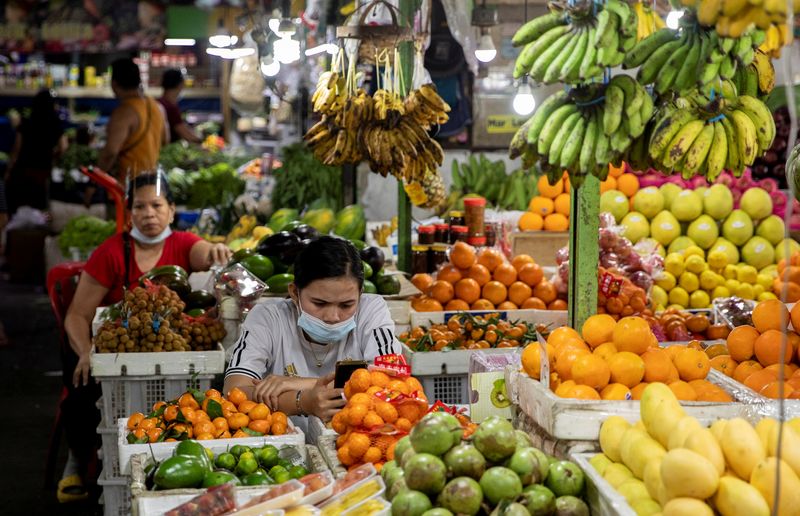
[ad_1]

© Reuters. FILE PHOTO-Vendors wearing face masks for protection against the coronavirus disease (COVID-19) stand by their fruit stalls at a public market in Quezon City, Metro Manila, Philippines, February 5, 2021. REUTERS/Eloisa Lopez
By Neil Jerome Morales and Enrico Dela Cruz
MANILA (Reuters) – Philippine annual inflation blew past expectations in January to reach a fresh 14-year high on surging food prices, raising the chance of the central bank delivering a bigger interest rate hike to tame prices when it meets this month.
The consumer price index (CPI) rose 8.7% in January, the statistics agency said on Tuesday, well above the 7.7% forecast in a Reuters poll and topping the 8.1% rate in December, when the central bank had expected prices to peak.
Core inflation, which strips out volatile food and fuel items, also increased to a more than two-decade high of 7.4%, from December’s 6.9%, suggesting price pressures remain broad.
The Philippine central bank, which had forecast January CPI to come in between 7.5%-8.3%, said on Saturday it will focus on inflation rather than the Federal Reserve’s most recent 25-basis point hike when it meets on Feb. 16 to review interest rates.
Given the faster-than-expected inflation in January, Bangko Sentral ng Pilipinas (BSP) looks certain to hike interest rates by at least 25 basis points and with a bigger 50 bps likely to be on the table, ING economist Nicholas Mapa said in a Tweet.
The Philippines’ broader stock index dropped 0.4% in early trade on expectations of a larger rate hike, while the peso had slipped 0.5% at 54.73 per dollar as of 0211 GMT.
The main factor behind January’s red-hot inflation was the 11.2% annual rise in food inflation, the quickest pace since 2009, and compared to the previous month’s 10.6%, and the 1.6% rate in the same month last year.
BSP Governor Felipe Medalla has previously signalled further rate hikes at the central bank’s first two policy meetings this year to bring inflation back within a target range of 2% to 4%.
Elevated inflation, plus the need to maintain interest rate differentials between the U.S. and the Philippines, have forced the central bank to embark on aggressive tightening, with the benchmark rate rising by a total of 350 bps last year.
Economic Planning Secretary Arsenio Balisacan said after the data was released that the impact of the central bank’s series of rate hikes in 2022 should be felt this year and result in a moderation in inflation starting in 2023.
[ad_2]